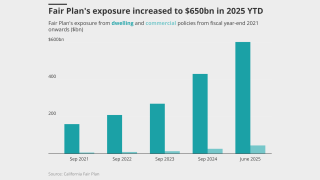Mercury General
-
This is the first rate filing to use the recently approved Verisk model.
-
Roughly half a year since the LA fires, brokers said there’s hope things are turning around.
-
Mercury’s recovery from the guaranteed percentage of losses is $47mn.
-
The company adjusts its rate options to expand California business under the new cat model.
-
The targeted uplift comes after Mercury ceded nearly $1.3bn of wildfire losses to reinsurers in Q1.
-
The insurer has not decided whether to sell its Eaton subrogation rights.
-
The ratings agency has revised Mercury’s outlook from stable to negative.
-
The company will ‘aggressively pursue subrogation’ for the Eaton Fire.
-
The LA-based carrier said it did not expect the event to result in credit defaults.
-
The LA-based firm estimated gross cat losses in the range of $1.6bn-$2bn.
-
Fitch said 1Q wildfire losses could add 6% to 10% to Mercury’s CoR.
-
The company’s stock price has plummeted in the wake of the LA wildfires.
-
Insurance Insider US runs you through the earnings results for the day.
-
Sources said that TMA ran a profitable book in California that included personal auto and homeowners’ policies.
-
The executive will continue reporting directly to Mercury General CEO Gabriel Tirador.
-
The Inside P&C news team runs you through the earnings results for the day.
-
Inside P&C’s morning summary of the key stories to get you up to speed fast.
-
The Inside P&C news team runs you through the earnings results for the day.
-
The cat losses outweighed the Q1 $15mn reserve charge that resulted from lower-than-estimated losses and loss adjustment expenses in the homeowners’ business.
-
The downgrades have been implemented due to the group’s significant earnings deterioration in 2022 and declining investment performance.
-
On Tuesday, the personal auto-focused carrier reported a 10.4-point deterioration in its combined ratio to 115.8%.
-
The carrier cited inflation, repair and part costs, supply chain issues and labor shortages as the drivers behind an increase in auto loss severity.
-
-
The carrier cited inflation, supply chain issues and labor shortages as the drivers behind an increase in auto loss severity and its third-quarter loss ratio compared to Q3 2021.


















